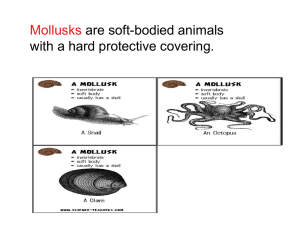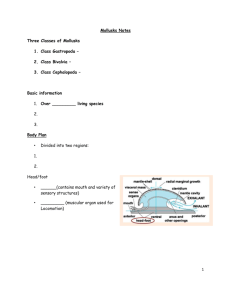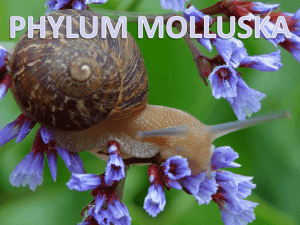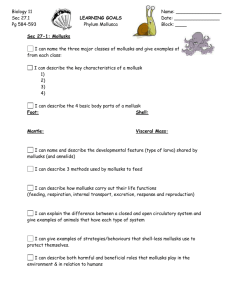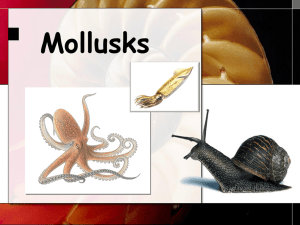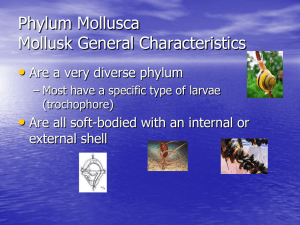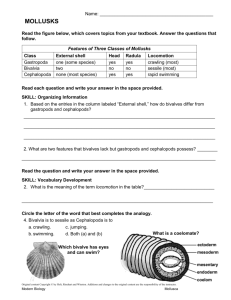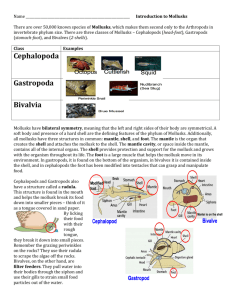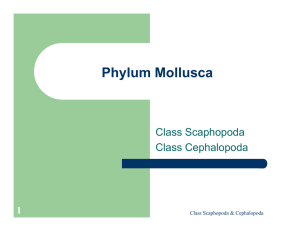Unit 6 PPT
advertisement
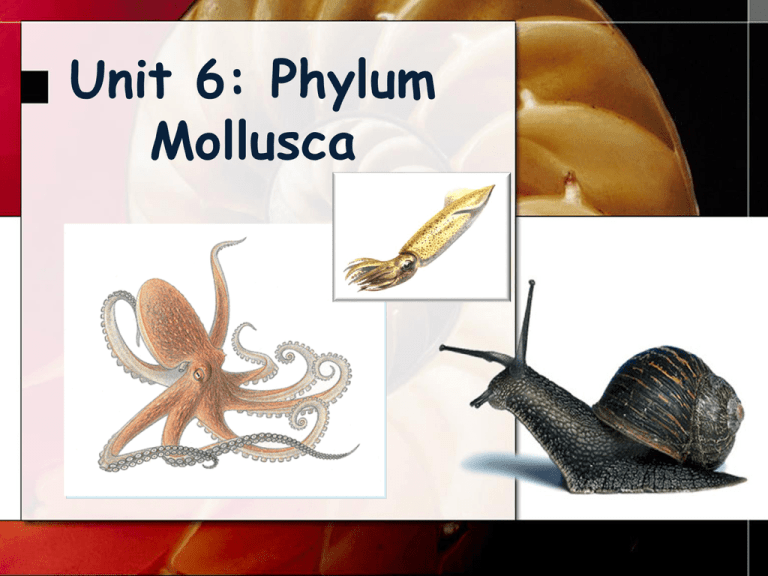
Unit 6: Phylum Mollusca I. General Characteristics Levels of Organization Specialized cells, tissues, and organs Body Symmetry Bilateral Symmetry Germ Layers Three Body Cavity True coelom Embryological Development Segmentation Protostome Cephalization Present Absent • Second largest animal phylum; over 110,000 species • Soft-bodied invertebrates • Most mollusks are marine • Some gastropods and bivalves inhabit freshwater ecosystems • A few gastropods (slugs & snails) are terrestrial (live on land). • Covered with protective mantle that may or may not form a hard, calcium carbonate shell • Have a muscular foot for movement which is modified into tentacles for squid & octopus • Complete, one-way digestive tract with a mouth & anus • Have a true coelom surrounding their heart • Cephalization - have a distinct head with sense organs & brain • Have a scraping, mouthlike structure called the radula • Go through freeswimming larval stage called trochophore • Range from microscopic to a giant squid (up to 70 ft. and 550 pounds) • Includes snails and slugs, oysters and clams, and octopuses and squids. II. Mollusk Body Plan 1. Evolution of a Coelom – Significant evolutionary advance in animals – Allows for the development of complex tissues and organs – Allowed for different body plans and architecture – Allowed for animals to grow larger than the simpler animals 2. Mollusk Body Plan All mollusks have a similar body plan with three main parts: 1. Muscular foot- used for movement and capturing prey; evolved into tentacles in cephalopods 2. Visceral mass – containing digestive, circulatory, respiratory and reproductive organs. 3. Mantle – houses the gills and in some secretes a protective shell over the visceral mass. General Body Plan of Mollusks Basic Body Plans for the Major Classes of Mollusks Head-Foot Region • Most mollusks have well developed head ends with sensory structures that may be simple light detectors or complex eyes (cephalopods). • The radula is a rasping, tongue like feeding structure found in most mollusks except bivalves. • Has tiny rows of teeth for scraping. 3. Reproduction • Most mollusks have male and female individuals • Some are hermaphrodites • Gastropods can reproduce by internal fertilization • Most aquatic mollusks reproduce by external fertlization • The life cycle of many mollusks includes a free swimming, ciliated larval stage called a TROCHOPHORE • It varies between mollusks, but it will eventually grow into an adult. III. Classes of Mollusks • Three major classes of mollusks: 1. Class Gastropoda – snails & slugs 2. Class Bivalvia – clams, mussels, oysters 3. Class Cephalopoda – octopus & squid Class Gastropoda • The shell of a gastropod is always one piece – univalve – and may be coiled or uncoiled. • The apex contains the oldest and smallest whorl. • Shells may coil to the right or left – this is genetically controlled. Class Gastropoda • Many snails can withdraw into the shell and close it off with a horny operculum. Gastropod Feeding Habits • Most gastropods are herbivores and feed by scraping off algae using the radula. • Some are scavengers of dead organisms • Others are carnivores that drill into other mollusks 2. Class Bivalvia • Bivalve mollusks have two shells (valves). • Mussels, clams, oysters, scallops, shipworms. • Mostly sessile filter feeders. • No head or radula. Class Bivalvia - Locomotion • Bivalves move around by extending the muscular foot between the shells. • Scallops and file shells swim by clapping their shells together to create jet propulsion. http://www.youtube.com/watch?v=u_RfgvIETEY&feature=related http://www.youtube.com/watch?v=vmi_I8QW5eo 3. Class Cephalopoda • Cephalopods include octopuses, squid, nautiluses and cuttlefish. • Marine carnivores with beak-like jaws Surrounded by tentacles modified from their foot. Class Cephalopoda - Shells • Shells of the Nautilus are made buoyant by a series of gas chambers. Class Cephalopoda - Shells • Cuttlefish have a small curved shell, completely enclosed by the mantle. Class Cephalopoda - Shells • In squid, the shell has been reduced to a small strip called the pen, which is enclosed in the mantle. Class Cephalopoda - Locomotion • Cephalopods swim by expelling water from the mantle cavity through a ventral funnel. Class Cephalopoda • Most cephalopods have complex eyes with cornea, lens, chambers, and retina. • Largest invertebrate brain • Closed circulation Protection • Color changes effected by chromatophores (pigment cells) • Allows them to blend into their background • Squirting out water by jet propulsion helps escape predators • Squids also release an inky substance into the water
